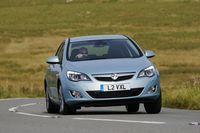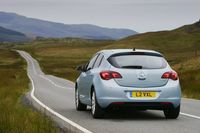Astra; Britainís best selling UK-built car is re-born and revitalised
Britain’s best selling UK-built car is re-born and revitalised
LUTON, UNITED KINGDOM – September 29, 2009: Launched at the 2009 Frankfurt Motor Show, Vauxhall’s all-new Astra is poised to raise the bar for compact cars sold in the UK, with a combination of stylish design, class-leading dynamics, ultra-efficient powertrains and upscale quality.
On sale now, and in UK showrooms from December, the new Astra will uphold Vauxhall’s tradition of offering buyers levels of innovation and technology normally found in a class above, but at a price point embedded in the value sector. New Astra prices start at £15,675 for the comprehensively equipped 1.4-litre, 87PS Exclusiv model and extend to £23,695 for the luxurious 2.0CDTi 160PS Elite automatic.
With a range of eight engines and five trim levels, the new Astra will initially be available as a five-door hatchback only, built at the Ellesmere Port plant in Cheshire, home to all Vauxhall’s compact-class cars since it opened 46 years ago.
Ellesmere Port will be responsible from launch for manufacturing all Astras sold across Europe, but UK buyers will take the lion’s share, amounting to 25 per cent of total production. Small wonder, then, that even in its outgoing form, the Astra is Britain’s best-selling UK-built car and one that is almost always seen in the top three sales listings.
What’s more, the Lower Medium Sector, in which the Astra sits, is hugely significant in the UK, accounting for 17.5 per cent of all retail car sales. With style-conscious buyers choosing Vauxhall more and more, the Astra has a large part to play in this success, along with its continued appeal to buyers in the fleet market.
“As with the Insignia, the Astra is an all-new car, continuing the transformation of the Vauxhall product range which started five years ago with the launch of the Mk 5 model,” said Andy Gilson, Vauxhall’s Marketing Director. “Also like the Insignia, the Astra aims to attract a new group of buyers, those who may never have considered a Vauxhall before, but now see cars like the new Astra as offering all the style and quality of a premium product, such as an Audi A3, but at a far more affordable price point. “
Mark Adams and his team execute yet another design
masterstroke
With its strong, cab-forward silhouette, steeply raked
windscreen and sloping rear roofline, the Astra makes ingenious use of many
of the design features found in the Insignia, but in a fresh and innovative
way. Also like the Insignia, it has spent over 600 hours in the wind
tunnel, benefiting performance, economy and overall refinement.
“We’re continuing with the same premium design cues as the Insignia,” said Mark Adams, Vice President of Design for GM Europe. “However, the main design themes, liked the wing-shaped signatures and the blade, needed an individual execution to avoid ‘cloning’ the model ranges.”
Upmarket design, quality materials and clever packaging define new
Astra’s cabin
Echoing the flowing forms of its bodywork, the
new Astra’s interior marks a major shift towards premium design and
quality in the compact sector. It employs the recurring wing and blade
motifs that were first introduced in the Insignia and are now used in a
fresh and innovative way.
Ambient lighting enhances the feeling of quality in the cabin, with lighting points framing the gearshift surround, the area above the centre console and within the door handle recesses, depending on trim level.
Unparalleled in this sector is the Astra’s raft of clever cabin storage solutions, some of which have even been patented. Rather than focusing on the compartment size alone, the Astra’s cabin is full of bespoke storage areas designed specifically for the 20 most common items buyers have been found to carry in their car, from an MP3 player to a 1.5-litre drinks bottle.
Efficient, yet powerful, Astra’s engines are low on CO2 but
high on power
The new Astra will be available with a range of eight
engines, ranging from 87PS to 180PS, all of which offer impressive
efficiency and an overall cut in emissions of 13.3 per cent compared with
the current Astra range.
Diesel engines are expected to represent almost half of all Astra sales, and will range from a 1.7-litre producing 110PS to a 2.0-litre generating 160PS, but will never emit more than 129g/km when fitted with a manual transmission.
Crucially, there will be an important ecoFLEX model, equipped with a 95PS 1.3 CDTi available in Spring 2010. Fitted with this engine, the ecoFLEX will achieve 109g/km, while retaining driveability and refinement.
There will also be five petrol engines available, ranging from an 87PS 1.4-litre to a 180PS 1.6-litre Turbo. Included in this line up will be a new 1.4-litre turbocharged engine, producing 140PS, replacing the 1.8-litre motor used in the current range. This new powertrain perfectly illustrates Vauxhall’s engine downsizing philosophy which provides drivers with all the performance of a larger capacity engine, but with far fewer emissions.
Innovative Watt’s link rear axle equals fine dynamics and
superior packaging
The new Astra’s front and rear tracks have
been increased by 56mm and 70mm respectively, while its wheelbase has been
increased by 71mm, the cumulative effect being improved handling and ride
quality, as well as more space and comfort for occupants.
Continuing Vauxhall’s trend for innovation, its engineers have combined the size, weight and efficiency benefits of a compound crank rear axle with a cleverly positioned Watt’s link, which helps support lateral forces during cornering.
Complementing this system is a new version of Vauxhall’s FlexRide adaptive damping system, which adjusts the suspension character automatically depending on the driver’s needs, while also offering three programmable damper settings.
Finally, a core body structure, stiffer than that of the outgoing car, enhances the new Astra’s ride and handling still further, while also reducing noise and vibration inside the cabin.
Illustrating Vauxhall’s commitment to developing its cars specifically for British roads and drivers, the new Astra has bespoke UK steering settings developed in conjunction with the Vauxhall Engineering Centre, based at GM’s Millbrook Proving Ground in Bedfordshire.
Vauxhall brings technology and innovation to the compact
class
While the Insignia succeeded in making new, high-tech innovations
accessible in the mid-size sector, Vauxhall has set itself an even more
ambitious goal in bringing most of these features to the compact sector
with the new Astra. These include:
Exterior Design
The next generation Astra brings a new look to the compact class, with
its strong coupe-like lines, elegant surfaces and its unique interpretation
of Vauxhall’s design language.
At 4.42 metres the new Astra grows by some 17 centimetres compared with its predecessor, positioning itself right between the Corsa (4.0 metres) and the Insignia (4.83 metres). The wheelbase increases by 71 millimetres, improving rear passenger space and adding comfort for all occupants.
A slim but low trapezoidal grille incorporating the latest Griffin logo dominates the front of the car, while the familiar blade sculpted into the side panels of the new Astra sweeps upward and visually connects with the side window-line, balancing the car’s proportions.
Eagle eye-shaped headlamps, that encompass the prominent wing-shaped daytime running lights, blend with a graceful flowing silhouette that connects the new car’s muscular shoulder lines with its distinctive rear hatch area.
“We carried forward the work we began with Insignia,” says Mark Adams, Vice President Design GM Europe. “This time we’ve given our design language a fresh expression for the compact class segment. Think of it as if the Insignia and Astra are members of a family. You can recognize the same gene pool, yet each car has its own personality and character.”
The raked A-pillars flow into a diving bonnet-line, leading to narrow headlamp units, housing lights mounted on a dark inner surface, which add depth and a three-dimensional quality. The signature wing graphic on the daylight running lights sits inside sharp, eagle-eye headlamps.
The front indicator lights are now located separately in the front bumper recesses and are accented with chrome, while the neatly shaped repeater units are set into the upper front wings.
New body design sees reappearance of the ‘Blade’
A
crisply-executed soft shoulder line runs along the side of the body into
the sculpted rear light units. Above these, the car’s windows on most
models are framed by a matt chrome surround, unique in the compact
class.
Pressed into the side panel just ahead of the rear wheels is the unmistakable blade motif, echoing the distinctive design cue in the front doors of the Insignia. On the new Astra, though, the blade swings upward in a rearward movement, providing the car with its own individual identity.
In profile, the car’s svelte proportions are accentuated by the triangular shape of the rear side window, the falling roof, the wraparound rear screen and the upward direction of the blade feature.
Coupe styling with hatchback functionality
The new
Astra’s side view hints at a sleek, almost coupť-like look, which
belies the Astra’s generous passenger accommodation, suitable for
five adults.
Viewed from behind, the shoulder line extends along the side of the body into the sculpted rear lights in one, continuous flow. Designers achieved the muscular rear proportions by creating strong rear body shoulders, combined with a wraparound C-panel and tapered rear window.
The tail light units are set apart to accentuate the width of the vehicle’s stance, and viewed at night, their double wing graphic creates an instantly recognisable appearance. This is enhanced by an upper rear spoiler, which also serves to improve the car’s aerodynamics.
Interior Design
Echoing the flowing forms of its bodywork, the new Astra’s
interior marks a major shift towards premium design and quality in the
UK’s compact sector, and continues Vauxhall’s design evolution
which started five years ago with the current Astra, followed by a further
step-change last year with the launch of the Insignia.
The Astra’s interior employs the recurring wing and blade motifs that were first introduced in the Insignia and are now used in a fresh and innovative way. The blade theme is expressed in details like the gooseneck shape of the door grab handles and the trim for the gearshift moulding and steering wheel.
As you look at the Astra’s wraparound instrument panel, which embraces both front seat occupants, the wing design is immediately visible as it arcs across the cabin into the door-top mouldings. The dashboard has a black, grained finish with a subtly different texture to other mouldings in the cabin.
Ambient lighting enhances the quality feel of the cabin, with lighting points framing the gearbox surround, and providing illumination from above the centre console and within the doorhandle recesses, depending on trim level.
The feeling of cabin space and depth is illustrated by a centre panel mounted at a shallow 30-degree angle, which sweeps down from the top of the instrument panel to the centre console, creating a flowing surface that incorporates the gearshift. Like the Insignia, the Astra’s main clocks and gauges are ringed with chrome, with the speedometer and tachometer pods angled inwards towards the driver.
Special emphasis has gone into the design and engineering of the Astra’s seats, which now have industry-leading levels of adjustment. Their height can be raised by up to 65mm, while their fore and aft range extends to 280mm, allowing all drivers and passengers to find their ideal seating position. In addition, the Ergonomic Sports Seats (standard in all Elite models) have improved tilt adjustment (driver’s seat only), four-way power lumbar support, superior side support and supporting foam pads.




